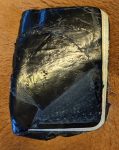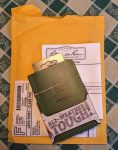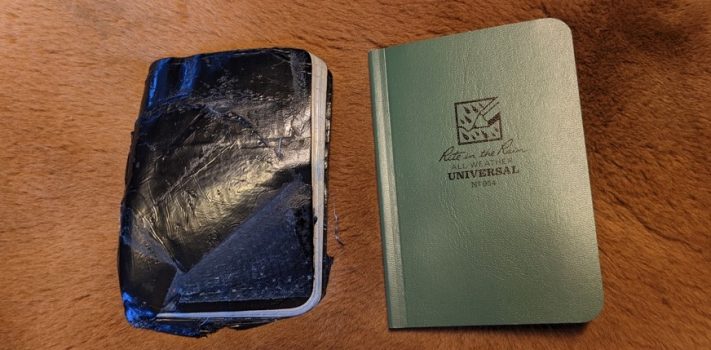Throughout history, mankind has chosen to record information using a variety of media: clay tablets, pieces of bone, slabs of wood, palm leaves, stone, parchment, papyrus, paper, USB drives, and a host of other media. Some of my favorite media are Rite in the Rain notebooks. I recently tested the Rite in the Rain No. 954 notebook, and found it to be an excellent choice for everyday carry. It is durable, moisture resistant, and reasonably priced (available at the time of this writing directly from Rite In The Rain for $6.95 plus shipping). I highly recommend it.
The Backstory
For many decades, I have carried small notebooks of various sorts in my left hip pocket, next to my handkerchief. I first started carrying a notebook in order to write down expenditures that I needed to enter into the budget each week. As time went on, I found the notebook to be useful for recording a host of other details that I might otherwise forget: phone numbers, door codes, passwords, parts numbers, etc.
The greatest challenge faced by my pocket notebooks was wear and tear. My pockets are a harsh environment for the objects they contain. The continued flexing motion produced by sitting on a notebook, standing up, and sitting on it again puts quite a bit of stress on the cover and the pages. Over the course of time, I have tried notebooks made by Avery, Mead, Barnes and Noble, Moleskine, and a host of other vendors. Most of these notebooks fell apart after about a year of use due to the stress of pocket carry.
 In January of 2016, I ordered a Rite in the Rain No. 754. It was a 112 page, black, 3.5″ X 5″ notebook made with a special water-resistant paper by the JM Darling company of Tacoma, Washington. That notebook held up well to six years of continuous use and abuse. The cover eventually ripped, but I patched it with black duct tape, and the notebook just kept functioning. I gradually filled its pages with carry out orders for fast food, part numbers for pieces of equipment, numeric codes for the key pads of the doors at my church, addresses, telephone numbers, packing lists, shopping lists, and (of course) expenditures that needed to be recorded in the budget.
In January of 2016, I ordered a Rite in the Rain No. 754. It was a 112 page, black, 3.5″ X 5″ notebook made with a special water-resistant paper by the JM Darling company of Tacoma, Washington. That notebook held up well to six years of continuous use and abuse. The cover eventually ripped, but I patched it with black duct tape, and the notebook just kept functioning. I gradually filled its pages with carry out orders for fast food, part numbers for pieces of equipment, numeric codes for the key pads of the doors at my church, addresses, telephone numbers, packing lists, shopping lists, and (of course) expenditures that needed to be recorded in the budget.
The notebook endured. I finally got to the place where there were only a couple of blank pages left in the book. It was time to look for a replacement.
Since old No. 754 had served so well, I decided to stick with a Rite in the Rain product. I contacted the JM Darling company and asked if they could supply a No. 954 for testing and evaluation. They were kind enough to agree. Several days later, a package arrived from Tacoma, Washington.
No. 954
Old No. 754 is black, but the No. 954 is green. I wanted a more natural color that would blend into the surrounding environment better during field use.
Like all other Rite in the Rain products, my new No. 954 is made in the USA.
 The information printed on the packaging in which the notebook is marketed advises that when the notebook is wet, one can write on the pages with pencil, a Rite in the Rain pen, wax marker, or crayon. Online reviewers have also noted that Fisher Space Pens work well on wet Rite in the Rain pages. I found this to be true in my testing.
The information printed on the packaging in which the notebook is marketed advises that when the notebook is wet, one can write on the pages with pencil, a Rite in the Rain pen, wax marker, or crayon. Online reviewers have also noted that Fisher Space Pens work well on wet Rite in the Rain pages. I found this to be true in my testing.
If the pages are dry, they can be written on with permanent markers or ballpoint pens. I used black ballpoint pens almost exclusively in old No. 754, and had good results even under somewhat damp conditions.
JL Darling does not recommend using water-based inks, gel pens, most highlighters, fountain pens, or water colors on Rite in the Rain paper.
The packaging indicates that the notebook, “will not only survive a downpour, it will also hold up to: sweat, mud, grime, and laundry.” Based on my experiences with old No. 754, I can attest to the accuracy of that statement.
The notebooks are unconditionally guaranteed against defects. If failure occurs during normal use, they request that the notebook be returned directly to JL Darling LLC, 2614 Pacific Highway E, Tacoma, WA 98424.
The JL Darling company was established in 1916. The packaging that came with the No. 954 reports the company history as follows:
The Rite in the Rain story began over a century ago in the forests of the Pacific Northwest. Entrepreneur Jerry Darling recognized the logging industry’s need for a durable material that could be written on and survive in poor weather conditions. Jerry developed a special coating that created a unique moisture shield on the hand-dipped sheets of paper that he and his wife, Mary, processed at their home. From these humble beginnings, our first all-weather paper was born. Over the many years we’ve perfected and patented our environmentally responsible coating process. Still located in Tacoma, our continued mission is to provide innovative products for professionals and enthusiasts who brave the outdoors.
Like old No. 754, the No. 954 measures 3.5″ X 5″ X .25″. It has 56 leaves (112 pages) between the covers. The covers are made of a slightly heavier material than the pages.
The inside front cover includes a 1/25,000 – 1/250,000 meter scale, a 1/50,000 meter scale, and a 1/100,000 meter scale. It also has a number of US to Metric and Metric to US Conversions, a table of various English Linear Measurements, and a number of Map Scales–English and Metric.
The back cover has inch and centimeter rulers printed along the edge.
I had torn so many pages out of old No. 754 over the years, that I had forgotten how thick the notebook was when new. But even with all 112 pages intact, the new No. 954 fits in my pocket quite comfortably. I did find that it was somewhat difficult to button the left rear pocket of my best pair of suit pants while that pocket contained the No. 954. Since I generally carry my notebook in a jacket pocket when I am wearing a suit, that is not a significant problem.
Pocket Testing
Pocket testing consisted of copying some useful information into the No. 954, putting in my back pocket, and carrying it every day. It proved to be a worthy successor to old No. 754. More than six weeks of daily carry and use under a variety of conditions resulted in no significant signs of wear and tear. I was very pleased, but not surprised based on my experiences with old No. 754.
The Water Test
 I tore a page from No. 954, filled a two-gallon bucket about half full, and immersed the page in the bucket. I then took a Fisher Space Pen that I tested for a recent article, and used it to write on the page underwater. Both paper and pen functioned flawlessly in this difficult environment.
I tore a page from No. 954, filled a two-gallon bucket about half full, and immersed the page in the bucket. I then took a Fisher Space Pen that I tested for a recent article, and used it to write on the page underwater. Both paper and pen functioned flawlessly in this difficult environment.
Notebook History
Most early writing media were unsuitable for notebook use. Clay tablets were too heavy, and papyrus tended to be too fragile.
One medium that was widely used for taking notes in the ancient world was broken pieces of pottery upon which notes were written with ink (ostraca),
Another early medium that was adapted for notebook use was wax tablets. A thin layer of wax on a thin layer of wood was light and compact enough to allow several such tablets to be fastened together notebook style. Another benefit of this medium was that the wax one the pages could be smoothed over to erase previous writing and allow the pages to be reused.
Parchment was even more suitable for notebook use. It was strong and flexible enough for pages to be sewn together along one edge to create the “codex” or book format. Small scraps of parchment from the trimmed edges of larger sheets could be bound together in this way to form the first small pocket notebooks.
Paper was developed in China sometime in the last couple of hundred years B.C. It gradually made it way west during the ensuing centuries, finally becoming common in Europe by the 15th century A.D. Early paper was made primarily from rags. As demand for paper outstripped the supply of rags, other sources of fiber suitable for paper making were sought. In the 1860s, it was discovered that wood pulp would work as a substitute. Rag fiber paper is generally better than wood pulp paper, since most wood pulp papers have a tendency to become brittle and turn yellow and then brown over time. But wood pulp paper is so much less expensive than rag fiber paper that it has largely replaced it in daily use.
Early paper notebooks were largely self-made, with notebook making considered an important skill for educated people. Then, with increasing industrialization, commercially produced notebooks came to predominate.
Conclusions
I have found Rite in the Rain notebooks to be durable, moisture-resistant, reasonably priced notebooks for everyday carry and a host of other uses. They are a good choice for those who need to write things down outdoors under field conditions.
Disclaimer
JM Darling LLC was kind enough to provide me with a Rite in the Rain No. 954 notebook for testing and evaluation. I tried not to let their kindness influence my evaluation of the product, and believe that I have succeeded in remaining objective. The Fisher Space Pen Company was kind enough to provide me with a model #SM4B Military Space Pen for testing and evaluation for a recent article. I did not receive any financial or other inducements to mention any vendor, product, or service in this article.










